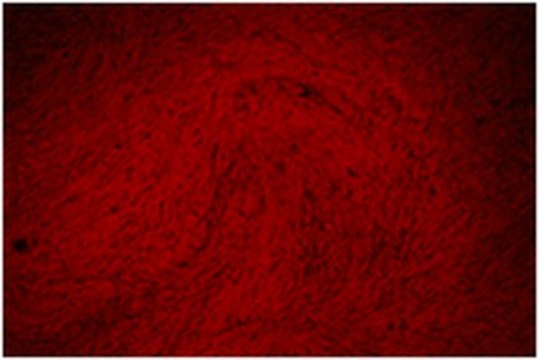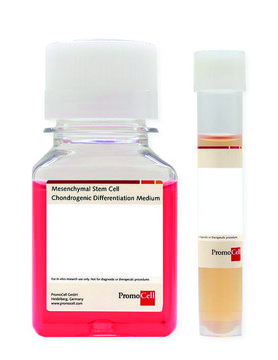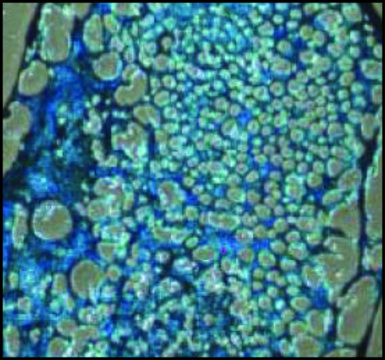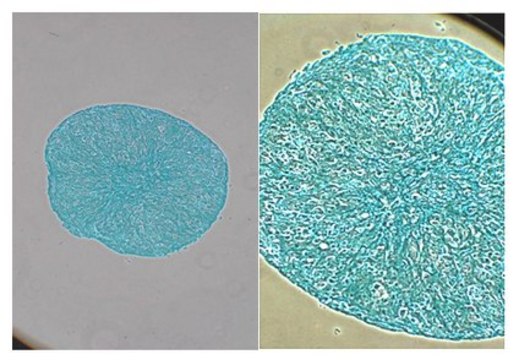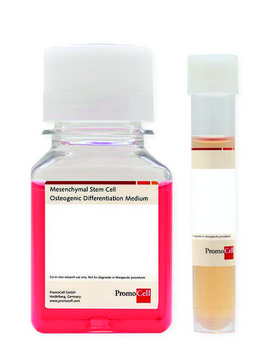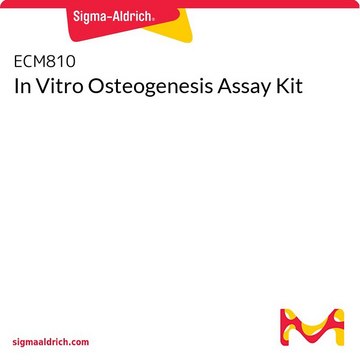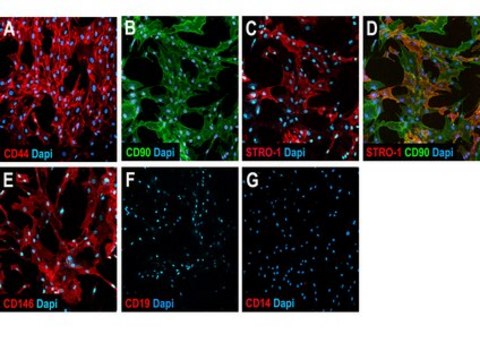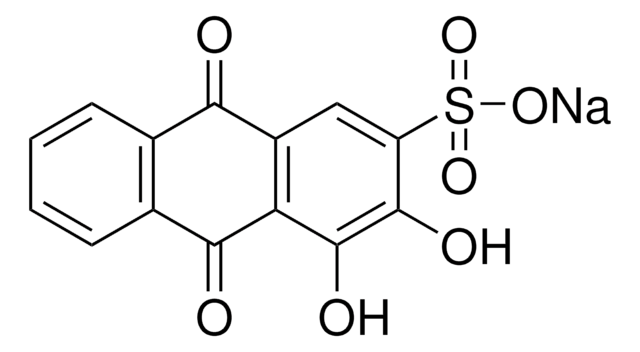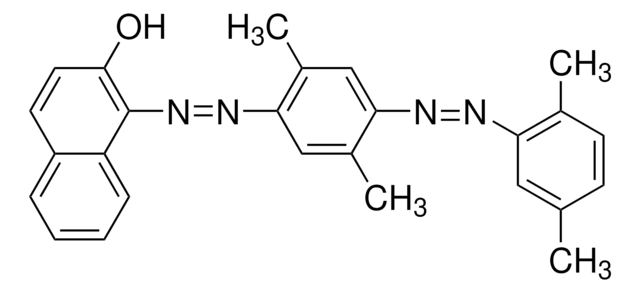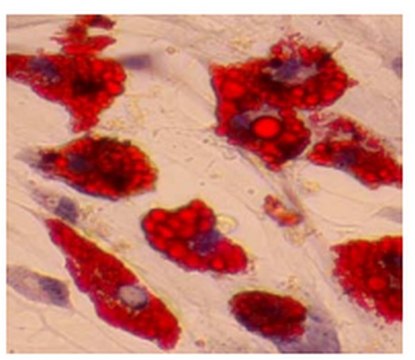SCR028
Mesenchymal Stem Cell Osteogenesis Kit
The Mesenchymal Stem Cell Osteogenesis Kit contains all the reagents necessary to readily differentiate mesenchymal stem cells to an osteogenic lineage as assessed by Alizarin Red staining.
登录查看公司和协议定价
所有图片(1)
About This Item
UNSPSC代码:
12352207
eCl@ss:
32161000
NACRES:
NA.81
推荐产品
质量水平
制造商/商品名称
Chemicon®
技术
cell culture | stem cell: suitable
输入
sample type mesenchymal stem cell(s)
检测方法
colorimetric
运输
wet ice
一般描述
Bone undergoes a continual remodeling process that requires the coordinated activity of two types of cells. Osteoclasts break down the bone matrix while osteoblasts deposits collagen, calcium, and phosphorous and other minerals to form new bone. The balance between the activity of osteoclasts and osteoblasts determine the mass and density of the bone. Many diseases of bone including osteoporosis, a common age-related phenomenon in post-menopausal women in which the bone mass has been greatly reduced, and osteogenesis imperfecta, also known as brittle-bone disease, are likely caused by the misregulation of osteoblasts and osteoclasts. Understanding the molecular mechanisms that underlie osteogenesis, the process by which new bone is formed is thus of critical importance.
Stem cell technology, particularly embryonic stem cells and/or mesenchymal stem cells, offer attractive sources of osteoblasts for tissue culture studies and for the biochemical dissection of the earliest steps involved in osteoblast cell determination. Mesenchymal stem cells are multipotent progenitor cells that have the capacity to differentiate into several mesenchymal cell lineages, including bone, cartilage and fat.
CHEMICON®′s Mesenchymal Stem Cell Osteogenesis Kit contains all the reagents necessary to readily differentiate mesenchymal stem cells to an osteogenic lineage as assessed by Alizarin Red staining. Reagents in the kit include two ECM coating molecules (collagen Type I and vitronectin) that have been shown to promote osteogenic differentiation of mesenchymal stem cells (Salasznyk, 2004) along with inducing reagents, dexamethasone, ascorbic acid 2-phosphate and b-glycerophosphate. Also included is Alizarin Red Solution, a staining solution that is used to detect the presence of calcium in bone.
Using CHEMICON′s Mesenchymal Stem Cell Osteogenesis Kit, we typically obtain >50% mature osteocytes from rat bone marrow derived mesenchymal stem cells. Efficiency of osteogenic differentiation may vary, depending upon the quality of the mesenchymal stem cells and if variations to the protocol are introduced.
For Research Use Only; not for use in diagnostic procedure.
Stem cell technology, particularly embryonic stem cells and/or mesenchymal stem cells, offer attractive sources of osteoblasts for tissue culture studies and for the biochemical dissection of the earliest steps involved in osteoblast cell determination. Mesenchymal stem cells are multipotent progenitor cells that have the capacity to differentiate into several mesenchymal cell lineages, including bone, cartilage and fat.
CHEMICON®′s Mesenchymal Stem Cell Osteogenesis Kit contains all the reagents necessary to readily differentiate mesenchymal stem cells to an osteogenic lineage as assessed by Alizarin Red staining. Reagents in the kit include two ECM coating molecules (collagen Type I and vitronectin) that have been shown to promote osteogenic differentiation of mesenchymal stem cells (Salasznyk, 2004) along with inducing reagents, dexamethasone, ascorbic acid 2-phosphate and b-glycerophosphate. Also included is Alizarin Red Solution, a staining solution that is used to detect the presence of calcium in bone.
Using CHEMICON′s Mesenchymal Stem Cell Osteogenesis Kit, we typically obtain >50% mature osteocytes from rat bone marrow derived mesenchymal stem cells. Efficiency of osteogenic differentiation may vary, depending upon the quality of the mesenchymal stem cells and if variations to the protocol are introduced.
For Research Use Only; not for use in diagnostic procedure.
应用
Research Category
Stem Cell Research
Stem Cell Research
The Mesenchymal Stem Cell Osteogenesis Kit contains all the reagents necessary to readily differentiate mesenchymal stem cells to an osteogenic lineage as assessed by Alizarin Red staining.
组分
Dexamethasone Solution: (Catalog No. 90357) One vial containing 100 μL of 10 mM dexamethasone in ethanol. Store at -20°C.
Ascorbic Acid 2-Phosphate Solution: (Catalog No. 2004011) One vial containing 500 μL of 100 mM ascorbic acid 2-phosphate in water. Store at -20°C.
Glycerol 2- Phosphate Solution: (Catalog No. 2004010) Three vials containing 1 mL of 1 M glycerol 2-phosphate in water. Store at -20°C.
Collagen, Type I: (Catalog No. 2004013) One vial containing 150 μg collagen Type I. Store at -20°C.
Vitronectin: (Catalog No. 2004012) One vial containing 150 μg vitronectin. Store at -20°C.
Alizarin Red Solution: (Catalog No. 2003999) One bottle containing 50 mL Alizarin Red Solution. Store at 2° to 8°C.
Ascorbic Acid 2-Phosphate Solution: (Catalog No. 2004011) One vial containing 500 μL of 100 mM ascorbic acid 2-phosphate in water. Store at -20°C.
Glycerol 2- Phosphate Solution: (Catalog No. 2004010) Three vials containing 1 mL of 1 M glycerol 2-phosphate in water. Store at -20°C.
Collagen, Type I: (Catalog No. 2004013) One vial containing 150 μg collagen Type I. Store at -20°C.
Vitronectin: (Catalog No. 2004012) One vial containing 150 μg vitronectin. Store at -20°C.
Alizarin Red Solution: (Catalog No. 2003999) One bottle containing 50 mL Alizarin Red Solution. Store at 2° to 8°C.
储存及稳定性
Note: Kit components require two different storage temperatures.
Dexamethasone Solution, Ascorbic Acid 2-Phosphate Solution, Glycerol 2- Phosphate Solution, Collagen Type I, and Vitronectin should be stored at -20ºC. Alizarin Red Solution should be stored at 2° to 8°C.
Precautions
· Dexamethasone is an irritant and potentially toxic. DMSO is readily absorbed through the skin. Wear a lab coat and gloves when handling these solutions.
Please refer to the Material Safety Data Sheet at www.chemicon.com for further precautions.
Dexamethasone Solution, Ascorbic Acid 2-Phosphate Solution, Glycerol 2- Phosphate Solution, Collagen Type I, and Vitronectin should be stored at -20ºC. Alizarin Red Solution should be stored at 2° to 8°C.
Precautions
· Dexamethasone is an irritant and potentially toxic. DMSO is readily absorbed through the skin. Wear a lab coat and gloves when handling these solutions.
Please refer to the Material Safety Data Sheet at www.chemicon.com for further precautions.
法律信息
CHEMICON is a registered trademark of Merck KGaA, Darmstadt, Germany
免责声明
Unless otherwise stated in our catalog or other company documentation accompanying the product(s), our products are intended for research use only and are not to be used for any other purpose, which includes but is not limited to, unauthorized commercial uses, in vitro diagnostic uses, ex vivo or in vivo therapeutic uses or any type of consumption or application to humans or animals.
警示用语:
Danger
危险分类
Eye Irrit. 2 - Flam. Liq. 2 - Repr. 1B - STOT SE 2
靶器官
Eyes,Central nervous system
储存分类代码
3 - Flammable liquids
闪点(°F)
48.2 °F
闪点(°C)
9 °C
法规信息
监管及禁止进口产品
Tapas R Nayak et al.
ACS nano, 5(6), 4670-4678 (2011-05-03)
Current tissue engineering approaches combine different scaffold materials with living cells to provide biological substitutes that can repair and eventually improve tissue functions. Both natural and synthetic materials have been fabricated for transplantation of stem cells and their specific differentiation
Jianying Zhang et al.
BMC musculoskeletal disorders, 11, 10-10 (2010-01-20)
Tendons are traditionally thought to consist of tenocytes only, the resident cells of tendons; however, a recent study has demonstrated that human and mouse tendons also contain stem cells, referred to as tendon stem/progenitor cells (TSCs). However, the differential properties
Pooi Ling Mok et al.
International journal of molecular sciences, 18(2) (2017-02-18)
Mesenchymal stem cells are widely used in many pre-clinical and clinical settings. Despite advances in molecular technology; the migration and homing activities of these cells in in vivo systems are not well understood. Labelling mesenchymal stem cells with gold nanoparticles
Yin Yin Ooi et al.
World journal of stem cells, 5(1), 34-42 (2013-01-31)
To assess the capacity to isolate and expand mesenchymal stem cells (MSC) from bone marrow of CBA/Ca, ICR and Balb/c mice. Bone marrow of tibia and femur were flushed, cultured and maintained in supplemented Dulbecco's modified Eagle's medium. MSC immunophenotype
Zul'atfi Rahmat et al.
Stem cell research & therapy, 4(1), 12-12 (2013-01-30)
Mesenchymal stem cells (MSCs) are immunosuppressive, but we lack an understanding of how these adult stem cells are in turn affected by immune cells and the surrounding tissue environment. As MSCs have stromal functions and exhibit great plasticity, the influence
我们的科学家团队拥有各种研究领域经验,包括生命科学、材料科学、化学合成、色谱、分析及许多其他领域.
联系技术服务部门